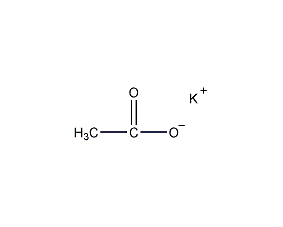
Structural formula
| Business number | 03KM |
|---|---|
| Molecular formula | C2H3KO2 |
| Molecular weight | 98.14 |
| label |
potassium acetate, potassium acetate, Potassium acetate hydrate, potassium diacetate, Genetic engineering research reagents |
Numbering system
CAS number:127-08-2
MDL number:MFCD00012458
EINECS number:204-822-2
RTECS number:AJ3325000
BRN number:3595449
PubChem number:24898171
Physical property data
1. Properties: colorless or white crystal, monoclinic system. It is easy to deliquesce and has a salty and bitter taste.
2. Relative density (25/4℃): 1.57
3. Melting point (℃): 292
4. Solubility: soluble in methanol, Ethanol and liquid ammonia are insoluble in ether and acetone.
Toxicological data
1. Acute toxicity: Rat oral LD5O: 3250mg/kg
Ecological data
None
Molecular structure data
None
Compute chemical data
1. Reference value for hydrophobic parameter calculation (XlogP):
2. Number of hydrogen bond donors: 0
3. Number of hydrogen bond acceptors: 2
4. Number of rotatable chemical bonds: 0
5. Number of tautomers:
6. Topological molecular polar surface area (TPSA): 40.1
7. Number of heavy atoms: 5
8. Surface charge: 0
9. Complexity: 34.6
10. Number of isotope atoms: 0
11. Determine the number of atomic stereocenters: 0
12. Uncertain number of atomic stereocenters: 0
13. Determine the number of chemical bond stereocenters : 0
14. Number of uncertain chemical bond stereocenters: 0
15. Number of covalent bond units: 2
Properties and stability
1. Basic properties
Colorless crystal or white crystalline powder. Easy to absorb moisture. Easily soluble in water and ethanol (1g product dissolves in 0.5ml cold water, 0.2ml boiling water, 2.9ml ethanol). Aqueous solutions react alkaline to litmus. The pH of 0.1mol/L aqueous solution is 9.7. Relative density 1.57. Melting point 292℃. Low toxicity, LD50 (rat, oral) 3250 mg/kg
During thermal decomposition, the intermediate product is potassium oxalate, and the final product is potassium carbonate.
Storage method
Store sealed and dry.
Synthesis method
1. Obtained from the reaction of glacial acetic acid and potassium hydroxide.
2. Take 2000g of potassium bicarbonate and add 1000g of water. Slowly add 650g of 98% acetic acid under heating and stirring. A large amount of carbon dioxide gas is produced. Controlled acid additionspeed so that the solution does not overflow. After adding acetic acid, boil the solution for about half an hour, cool slightly and then filter. The filtrate is evaporated under constant stirring until the temperature reaches 160-180°C, at which time most of the crystals precipitate. Stir vigorously, cool, and filter out the crystals.

3. Neutralize with potassium hydroxide and acetic acid aqueous solution, the solution was concentrated to precipitate crystals, and the resulting crystals were dried at 180°C for 1 day.
Purpose
1. This product is used as a dehydrating agent, fiber treatment agent and analytical reagent. In the pharmaceutical industry, as a culture medium for Penicillium, potassium acetate is used as raw material in the production of cortisone acetate, prednisolone acetate, dexamethasone acetate, betamethasone, and fluocinolone acetate.
2. Used as analytical reagents and catalysts.
3.Used as analytical reagent to adjust ph value. Used as desiccant. Make clear glass. Used in the pharmaceutical industry.
4.Can be used to treat fluoroplastics in the molten state at 295℃/30min to improve the surface bonding performance. Also used as dehydrating agent and buffering agent. It can also catalyze the reaction between CTBN terminal carboxyl groups and epoxy groups.

 微信扫一扫打赏
微信扫一扫打赏

